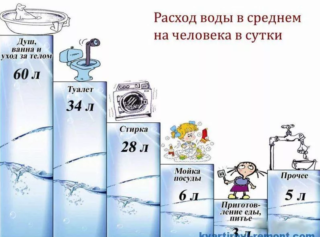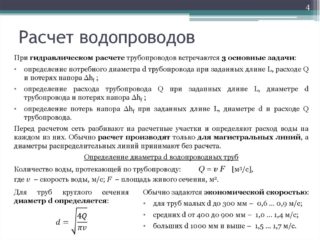When laying water supply networks in a country house or mini-hotel, the permeability of pipes must be taken into account. It shows the maximum volume of liquid passing through the main network for a specific time interval. This allows you to find out how much moisture will escape when the taps are open, and compare the resulting value with the estimated water consumption of the residents of the house. The easiest way is to calculate the water consumption by the pipe diameter and pressure, since these indicators are easy to find out.
The need to calculate the water flow by the pipe diameter and pressure
The calculated indicators will help you select pipes of the desired section with a suitable wall thickness and determine the material for their manufacture. Also, in accordance with these values, the technology for installing the highway is selected.
The easiest way is to calculate how much water is consumed per hour, day or month if a meter is installed. If there is no metering device, according to the standards, one person is able to use up the following volume of cold water every day:
- cooking - 3 l;
- using a washing machine - about 4 liters;
- toilet procedures - 15 liters;
- morning or evening shower - 30 l;
- taking a bath - 200 liters.
In a private house with an autonomous water supply, hot water is created by heating cold water using boilers or gas water heaters, so the consumption of the latter increases. 330 liters of water can be consumed here per day for the needs of one person. This number will be approximately 10,230 liters per month, and 13.75 liters per hour.
These standards are approximate. They do not include factors such as pet maintenance, aquarium and pool water changes, car washing, and planting watering. You also need to take into account the tenants' work schedule and seasonality. But the average indicators are needed so that there is something to start from in the calculations.
Private business owners also need to know the estimated maximum consumption. In the absence of water meters, utilities will calculate the volume of water consumption depending on the throughput of pipes. If the owner of the premises knows these indicators, he will be able to control the calculations and will not pay extra.
Factors influencing the calculations
- The length of the water main. The longer the length, the lower the speed capabilities of the water flow due to the action of the friction force.
- Pipe section. Narrow pipe walls provide increased resistance. The smaller the inner diameter, the lower the ratio of the speed value of the water flow to the indicator of the surface area in a certain area, which means that the permeability will be worse. In lines of large cross-section, the liquid flows faster.
- The presence of turning sections. The complex configuration of the pipeline slows down the speed of the water flow in it. The same goes for fittings.Any taps, adapters and couplings inhibit the movement of fluid.
It is also important to take into account the material of the pipe sections. Both the throughput of the network and the duration of service depend on this. Metal water pipes tend to deform over time under the influence of rust, accumulate corrosive and lime deposits from the inside, which greatly reduces the flow capacity. The latter is typical not only for steel, but also for cast iron pipes, although they are less susceptible to corrosion.
The resistance to water flow of a clogged line is much higher than that of a new pipeline: the indicators can differ by up to 200 times. DHW pipes become clogged especially quickly.
Polymer lines maintain practically the same passability throughout the entire service life. Plastic is not susceptible to corrosion, is not afraid of mold and mildew accumulations, thanks to which blockages in the pipeline are extremely rare.
Payment methods
To determine the water flow rate of the line, three calculation methods are used:
- Physical method. Formulas are applied to determine the required value. They use parameters such as pipe diameter, water pressure and the speed of movement of the contents of the pipes in the system.
- Application of tables. A fairly easy method, which involves the selection of the necessary indicators in the table and finding out the necessary data on their basis.
- Use of computer programs. There are quite a few such options on the World Wide Web. You can find out the throughput and water consumption for pipelines made of various materials, simply by entering the required known data.
To calculate consumption figures before building a country house, the easiest way is to use online calculators. By entering the values of pressure and pipe diameter, you will receive a figure for the probable flow rate. It will not be perfectly accurate, but this method does not require any calculations. To clarify the data, check the software calculation against the tabular values.
Using tables
Excluding calculator counting, this method is the easiest. Several similar tables have been developed: you can choose the one that is suitable depending on the known data. In SNiP 2.04.01-85, it is proposed to calculate the water flow along the outer section of the pipe. For this, a table of the maximum flow rate of water passing through a pipe of a certain outer diameter is used:
| Pipe circumference (mm) | Water consumption | |
| In l / min | In cube / hour | |
| 20 | 15 | 0,9 |
| 25 | 30 | 1,8 |
| 32 | 50 | 3 |
| 40 | 80 | 4,8 |
| 50 | 120 | 7,2 |
| 63 | 190 | 11,4 |
This is the simplest calculation table, in which you only need to know the pipe coverage. To refine the data, you can enter additional indicators - wall thickness and internal diameter. Similar tables are easy to find on the Internet for pipelines made of various materials.
When calculating the consumption maximums in the water main, not only the diametrical indicator, but also the flow head is taken into account.
Another table allows you to identify the maximum water consumption, based on the above values:
| Consumption | Bandwidth | |||||||||
| Pipe section (mm) | 15 | 20 | 25 | 32 | 40 | 50 | 65 | 80 | 100 | |
| Pa / m | Mbar / m | Less than 0.15 m / s | 0.15 m / s | 0.3 m / s | ||||||
| 90 | 0,9 | 173 | 403 | 745 | 1627 | 2488 | 4716 | 9612 | 14940 | 30240 |
| 92,5 | 0,925 | 176 | 407 | 756 | 1652 | 2524 | 4788 | 9756 | 15156 | 30672 |
| 95 | 0,95 | 176 | 414 | 767 | 1678 | 2560 | 4860 | 9900 | 15372 | 31104 |
| 97,5 | 0,975 | 180 | 421 | 778 | 1699 | 2596 | 4932 | 10044 | 15552 | 31500 |
| 100 | 1000 | 184 | 425 | 788 | 1724 | 2632 | 5004 | 10152 | 15768 | 31932 |
| 120 | 1200 | 202 | 472 | 871 | 1897 | 2898 | 5508 | 11196 | 17352 | 35100 |
| 140 | 1400 | 220 | 511 | 943 | 2059 | 3143 | 5976 | 12132 | 18792 | 38160 |
| 160 | 1600 | 234 | 547 | 1015 | 2210 | 3373 | 6408 | 12996 | 20160 | 40680 |
| 180 | 1800 | 252 | 583 | 1080 | 2354 | 3589 | 6804 | 13824 | 21420 | 43200 |
| 200 | 2000 | 266 | 619 | 1151 | 2488 | 3780 | 7200 | 14580 | 22644 | 45720 |
| 220 | 2200 | 281 | 652 | 1202 | 2617 | 3996 | 7560 | 15336 | 23760 | 47880 |
| 240 | 2400 | 288 | 680 | 1256 | 2740 | 4176 | 7920 | 16056 | 24876 | 50400 |
| 260 | 2600 | 306 | 713 | 1310 | 2855 | 4356 | 8244 | 16740 | 25920 | 52200 |
| 280 | 2800 | 317 | 742 | 1364 | 2970 | 4356 | 8568 | 17338 | 26928 | 54360 |
| 300 | 3000 | 331 | 767 | 1415 | 3078 | 4680 | 8892 | 18000 | 27900 | 56160 |
The average pressure ranges from 1.5 to 4 bar. The use of additional pressure devices will affect the flow rate. When calculating the maximum flow rate when a liquid flows through a pipe, not only the number of taps, but also the number of other consumers are taken into account.
Using formulas
Several equations are used to calculate the water flow based on the cross-section of the pipes and the pressure in their walls. The simplest formula: q = π × d² / 4 × V.
- q is the flow rate of the liquid in liters;
- d is the pipe diameter in centimeters;
- V is the speed of movement of the water flow.
In domestic highways, powered from a water tower without connecting pumping devices, its value will be 0.7 - 1.9 m / s. If any pressure equipment is connected, then the technical documentation contains data on the coefficient of the created pressure and the speed indicator of the fluid being moved.
When calculating the possible flow rate, the possible pressure drop must also be taken into account. To calculate this indicator, the standard equation Δp = (λL / d) ρw² / 2 is taken as a basis.
- L is the length of the pipe;
- d is its diameter;
- ρ is the density of water;
- w is the speed of the water flow;
- λ is the coefficient of friction.
The latter is revealed depending on the speed and cross-section of the line according to the tables.
Further, knowing the indicators of potential flow rate and head loss, you can use tables and graphs to identify the exact value of the flow rates of liquid in specific pipes, or use calculators, which is easier. If you wish, you can even calculate the water consumption in liters for one specific procedure in a particular house.
Knowing the indicators of the maximum water consumption in a certain pipeline, it is possible to draw up a correct project for the position of the main network, taking into account all connected water consumers. Also, understanding specific numbers will save water and electricity when connecting pressure devices. With the right choice of values, there will be no cause for concern due to the fact that when you open the tap in the kitchen, the water in the shower will turn into a thin trickle due to a decrease in pressure.










